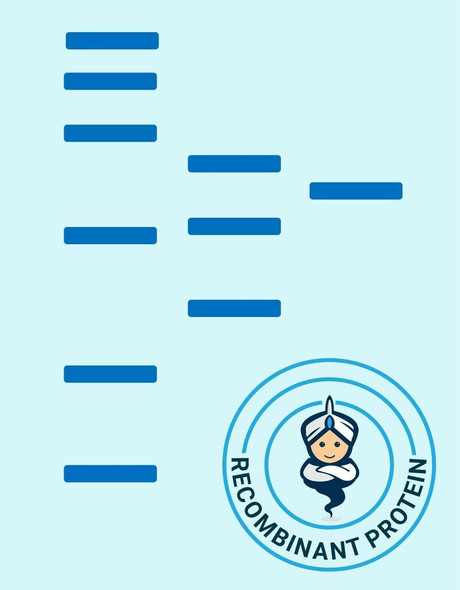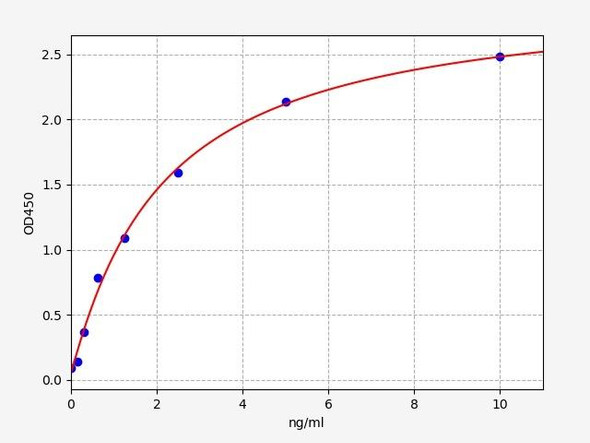Human NANOG Recombinant Protein (RPPB4053)
- SKU:
- RPPB4053
- Product type:
- Recombinant Protein
- Size:
- 20ug
- Species:
- Human
- Target:
- NANOG
- Synonyms:
- NANOG
- Homeobox protein NANOG
- Homeobox transcription factor Nanog
- hNanog
- Source:
- Escherichia Coli
- Uniprot:
- Q9H9S0
Description
| Product Name: | Human NANOG Recombinant Protein |
| Product Code: | RPPB4053 |
| Size: | 20µg |
| Species: | Human |
| Target: | NANOG |
| Synonyms: | NANOG, Homeobox protein NANOG, Homeobox transcription factor Nanog, hNanog. |
| Source: | Escherichia Coli |
| Physical Appearance: | Sterile Filtered colorless solution. |
| Formulation: | NANOG protein (0.25mg/ml) is supplied in 20mM Tris-HCL, pH-8, 1mM DTT and 20% Glycerol. |
| Stability: | Store at 4°C if entire vial will be used within 2-4 weeks. Store, frozen at -20°C for longer periods of time. For long term storage it is recommended to add a carrier protein (0.1% HSA or BSA).Avoid multiple freeze-thaw cycles. |
| Purity: | Greater than 90.0% as determined by SDS-PAGE. |
| Amino Acid Sequence: | MGSSHHHHHH SSGLVPRGSH MSVDPACPQS LPCFEASDCK ESSPMPVICG PEENYPSLQM SSAEMPHTET VSPLPSSMDL LIQDSPDSST SPKGKQPTSA EKSVAKKEDK VPVKKQKTRT VFSSTQLCVL NDRFQRQKYL SLQQMQELSN ILNLSYKQVK TWFQNQRMKS KRWQ |
NANOG is a multidomain homeobox transcription factor which functions to maintain the undifferentiated state of pluripotent stem cells. NANOG expression counteracts the differentiation-promoting signals induced by the extrinsic factors LIF, Stat3 and BMP. Once NANOG expression is downregulated, cell differentiation can proceed. Proteins which regulate NANOG expression include transcription factors Oct4, SOX2, FoxD3, and Tcf3 and tumor suppressor p53.
NANOG Human Recombinant produced in E.coli is a single, non-glycosylated polypeptide chain containing 174 amino acids (1-154) and having a molecular mass of 19.6 kDa.The NANOG is fused to a 20 amino acid His-Tag at N-terminus and purified by proprietary chromatographic techniques.
| UniProt Protein Function: | NANOG: Transcription regulator involved in inner cell mass and embryonic stem (ES) cells proliferation and self-renewal. Imposes pluripotency on ES cells and prevents their differentiation towards extraembryonic endoderm and trophectoderm lineages. Blocks bone morphogenetic protein-induced mesoderm differentiation of ES cells by physically interacting with SMAD1 and interfering with the recruitment of coactivators to the active SMAD transcriptional complexes. Acts as a transcriptional activator or repressor. Binds optimally to the DNA consensus sequence 5'-TAAT[GT][GT]-3' or 5'-[CG][GA][CG]C[GC]ATTAN[GC]-3'. When overexpressed, promotes cells to enter into S phase and proliferation. Interacts with SMAD1 and SALL4. Expressed in testicular carcinoma and derived germ cell tumors. Expressed in fetal gonads, ovary and testis. Also expressed in ovary teratocarcinoma cell line and testicular embryonic carcinoma. Not expressed in many somatic organs and oocytes. Belongs to the Nanog homeobox family. 2 isoforms of the human protein are produced by alternative splicing. |
| UniProt Protein Details: | Protein type:Transcription factor; DNA-binding; Cell development/differentiation Chromosomal Location of Human Ortholog: 12p13.31 Cellular Component: nucleoplasm; nucleolus; nucleus Molecular Function:DNA binding; chromatin binding; transcription factor activity; transcription corepressor activity Biological Process: response to retinoic acid; gonad development; transcription, DNA-dependent; somatic stem cell maintenance; stem cell division; endodermal cell fate specification; stem cell maintenance; negative regulation of transcription from RNA polymerase II promoter; positive regulation of mitotic cell cycle; embryonic pattern specification; mesodermal cell fate commitment; negative regulation of cell fate commitment; negative regulation of BMP signaling pathway; cell proliferation; regulation of transcription, DNA-dependent; regulation of gene expression; regulation of cell differentiation; positive regulation of cell proliferation; positive regulation of transcription from RNA polymerase II promoter; cell differentiation |
| NCBI Summary: | The protein encoded by this gene is a DNA binding homeobox transcription factor involved in embryonic stem (ES) cell proliferation, renewal, and pluripotency. The encoded protein can block ES cell differentiation and can also autorepress its own expression in differentiating cells. Two transcript variants encoding different isoforms have been found for this gene. [provided by RefSeq, Sep 2015] |
| UniProt Code: | Q9H9S0 |
| NCBI GenInfo Identifier: | 118573073 |
| NCBI Gene ID: | 79923 |
| NCBI Accession: | Q9H9S0.2 |
| UniProt Secondary Accession: | Q9H9S0,Q2TTG0, Q6JZS5, D3DUU4, |
| UniProt Related Accession: | Q9H9S0 |
| Molecular Weight: | 305 |
| NCBI Full Name: | Homeobox protein NANOG |
| NCBI Synonym Full Names: | Nanog homeobox |
| NCBI Official Symbol: | NANOG |
| NCBI Protein Information: | homeobox protein NANOG; homeobox transcription factor Nanog; homeobox transcription factor Nanog-delta 48 |
| UniProt Protein Name: | Homeobox protein NANOG |
| UniProt Synonym Protein Names: | Homeobox transcription factor Nanog; hNanog |
| Protein Family: | NANOG neighbor homeobox |
| UniProt Gene Name: | NANOG |
| UniProt Entry Name: | NANOG_HUMAN |










